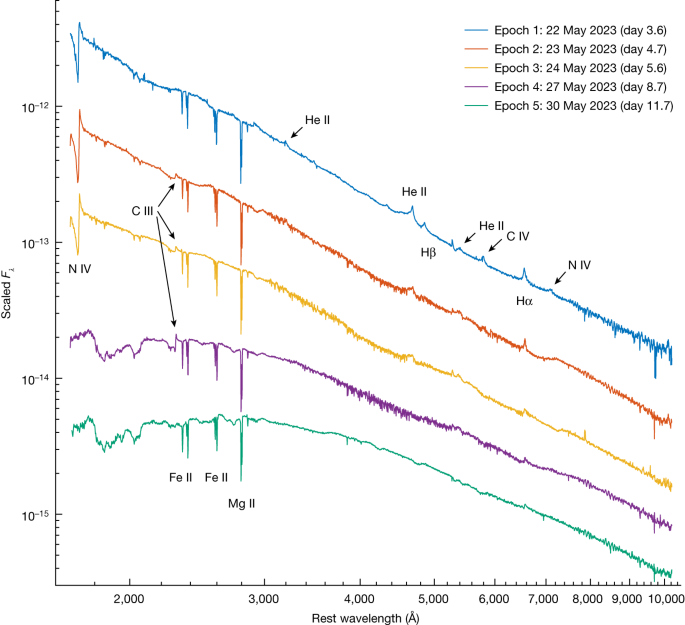Unveiling the Complex Circumstellar Environment of Supernova 2023ixf
Core Concepts
Understanding the early evolution of supernova SN 2023ixf reveals insights into the surrounding environment and the progenitor star.
Abstract
The content discusses how the early evolution of a supernova can provide valuable information about the environment and the star that exploded. It highlights the differences in the appearance of the first photons escaping from a star exploding in a vacuum versus one exploding within dense circumstellar material. The article focuses on the observations of SN 2023ixf in the galaxy Messier 101, detailing the use of UV spectra and multiwavelength observations to analyze the emergence of the explosion shock from a thick medium. The study results in a reliable bolometric light curve that sheds light on the nature of the shock breakout from a dense layer.
Early evolution of a supernova reveals details about the environment and progenitor star.
Differences in photon escape patterns between stars exploding in vacuum and those within dense circumstellar material.
Observations of SN 2023ixf in Messier 101 using UV spectra and multiwavelength data.
Analysis of the emergence of the explosion shock from a thick medium.
Derivation of a reliable bolometric light curve indicating the shock breakout from a dense layer.
The complex circumstellar environment of supernova 2023ixf - Nature
Stats
The first photons to escape from a star exploding within dense circumstellar material can extend the initial flare duration to several days.
UV spectra of SN 2023ixf in Messier 101 were used to temporally resolve the emergence of the explosion shock.
The shock breakout from a dense layer had a radius substantially larger than typical supergiants.
Quotes
"Using UV data and multiwavelength observations, we temporally resolve the emergence of the explosion shock from a thick medium."
Key Insights Distilled From
by E. A. Zimmer... at www.nature.com 03-27-2024
https://www.nature.com/articles/s41586-024-07116-6
Deeper Inquiries
How does the study of supernova evolution contribute to our understanding of the universe
Studying the evolution of supernovae provides crucial insights into various aspects of the universe. Firstly, it helps us understand the life cycles of stars, from their formation to their explosive deaths. By analyzing the early phases of a supernova, such as the shock-breakout flare and subsequent emission, scientists can gather information about the progenitor star's characteristics, like its mass, size, and composition. This knowledge contributes to our understanding of stellar evolution and the processes that govern the birth and death of stars. Furthermore, studying supernova evolution allows us to probe the surrounding environment, such as circumstellar material, which can reveal details about the star's history and interactions with its surroundings. Overall, the study of supernova evolution is essential for unraveling the mysteries of the cosmos and advancing our knowledge of astrophysical phenomena.
What potential challenges or limitations could arise from analyzing supernova data in different wavelengths
Analyzing supernova data in different wavelengths poses several challenges and limitations. One major challenge is the need for comprehensive multiwavelength observations to capture the full spectrum of the supernova's emission. Different wavelengths provide unique information about the supernova's properties, such as temperature, composition, and expansion velocity. However, coordinating observations across various wavelengths can be logistically complex and require sophisticated instrumentation. Additionally, interpreting data from different wavelengths requires expertise in diverse areas of astrophysics, such as spectroscopy, radiative transfer, and high-energy physics. Differences in observational techniques and calibration standards between different wavelengths can also introduce uncertainties and biases in the analysis. Therefore, careful consideration and cross-validation of data from multiple wavelengths are essential to ensure accurate and reliable results in supernova studies.
How can the findings of this research impact future studies on supernova explosions
The findings of the research on supernova SN 2023ixf in galaxy Messier 101 can have significant implications for future studies on supernova explosions. By resolving the emergence of the explosion shock from a dense circumstellar medium using UV spectra and multiwavelength observations, this research provides a detailed understanding of the early phases of supernova evolution. The identification of a dense layer with a radius larger than typical supergiants suggests unique conditions surrounding the progenitor star of SN 2023ixf. These findings can guide future observational campaigns and theoretical models of supernova explosions, helping researchers refine their understanding of the diversity of supernova environments and progenitor stars. Moreover, the insights gained from this study can inform future studies on stellar evolution, supernova nucleosynthesis, and the impact of supernovae on galaxy evolution. Overall, the research on SN 2023ixf opens up new avenues for investigating the complex circumstellar environments of supernovae and advancing our knowledge of these cosmic events.
0
